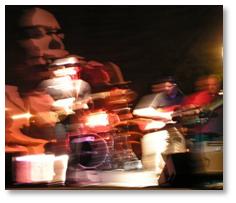The Music of Beer
Posted by jjdavis on 16 Mar 2007 at 12:05 pm | Tagged as: Beer People
I had a great chat today with Grant Wood, the Brewing Manager of the Samuel Adams Boston Beer Company. He’s the man in the know and the keeper of beer secrets.
 I’d done a bit of research and discovered that Grant went to Siebel Institute of Chicago, oldest among America’s brew schools, and was also a native of Irving, Texas — not far away from where I live now. The idea of a School of Beer had me intrigued, and that was the first thing I asked him about. “So, what is it like? Is it a studious experience or more like a scene from Animal House?”
I’d done a bit of research and discovered that Grant went to Siebel Institute of Chicago, oldest among America’s brew schools, and was also a native of Irving, Texas — not far away from where I live now. The idea of a School of Beer had me intrigued, and that was the first thing I asked him about. “So, what is it like? Is it a studious experience or more like a scene from Animal House?”
He laughed. “No. Not quite like that.” Grant went on to say they spent most of their 12 weeks in lectures about the various ingredients, methods, etc., as one would expect in any learning environment. But he says the highlight of the experience was the field trips to various breweries and pubs of the area, to see different methods of brewing and, of course, to go beer tasting. He learned a lot and made good connections — some of his fellow classmates went on to hold high positions at other large breweries across the country.
“I’ve noticed that at my local beer heaven,” I said, “all the beers now have cards showing what beers go with which foods. Is this an industry wide thing?”
“I’m not sure if it’s industry wide, but it makes sense.”
“Do you believe beer goes better with food than does wine?”
“Yes,” Grant said, “I do. It does, and for a variety of different reasons.” He went on to talk about how beer’s large variety of ingredients make a much more diverse array of flavors. More flavors mean better matches with different foods. “Also, because there’s less alcohol content, the flavors in the beer compliment the food instead of overwhelming it. Not only that, there’s the carbonation which serves to scrub the pallet.”
“I always felt beer went better with food than wine,” I told him. “I just didn’t know why.” I went on to explain about how I’m searching for the Holy Beer for my novel, and asked what he thought it was that makes some beers extraordinary.
“Complexity, and depth of flavor,” Grant said. “A really good beer hits the pallet with a succession of flavors, similar to notes in a song. And like in music, these flavors have to be delivered rapidly and in harmony, without sounding any discordant notes. When the beer is finished, the very last taste should fade pleasantly. It doesn’t matter how good a beer is if — when you’re finished with it — it leaves you searching for something to remove the final taste from your mouth.”
“The Westmalle Dubbel Ale I had the other night did just that,” I said. “It finished up bitter and nasty, kind of like a cigar butt.”
Grant laughed. “No, that’s not something you want to have happen. Ideally at the end of a beer its flavor should leave you wanting another.”
“You guys are good at that. Especially the Old Ale. The one from your LongShot pack — I loved it.”
“Yes. Don Oliver did a really good job with that one. That’s a good recipe.”
“I’ve got one final question for you. What do you see for the future of beer? Any new directions, new types of beer?”
Grant said he couldn’t speak for the brewery, but from a personal perspective he thinks we’ll see a more blurring of lines. “Jim Koch wants to push the envelope of what a beer can be. We see it already with fruit beers and barley wines, and in the future I think the market will see more hybrids. People want new flavors — but at the same time they still want a sense of authenticity.”
“Hybrids such as those ‘buzz beers’ on the market today?”
“Well, yes, but hopefully something more elegant. We’ll probably see beverages where you’re not really sure if it’s a beer or a wine. Things that really push the envelope.”
“How about packaging? With the big push to be ‘green’ I was wondering if the industry might resort to reusable bottles and the like?”
“We’re experimenting with that. There has to be a balance between a container that can be reused and still looks good enough to put your product in. We’re doing some of that now, trying to use recycled glass and also paper in our packaging.”
With that, I thanked Grant and told him I didn’t want to take up any more from his busy day. After all, the beer must flow. Once we said our goodbyes and hung up, I opened up a bottle of their Brown Ale — the next beer on my list to review — and thought about Grant’s musical analogy for beer’s flavor.
Each flavor a note, each beer a different song.
I like that.
Comments Off on The Music of Beer
